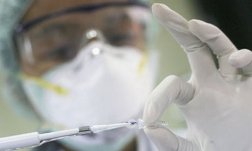 A Dutch laboratory claiming to have developed a deadly strain of bird flu wants to publish its research, sparking fears that terrorists could use the information.
A Dutch laboratory claiming to have developed a deadly strain of bird flu wants to publish its research, sparking fears that terrorists could use the information.
Scientists at the Erasmus Medical Centre in Rotterdam say they have been able to mutate the H5N1 virus so that it can be transmitted through the air.
Until now it was thought it could be transmitted between humans only via close physical contact.
The Netherlands team, led by virologist Ron Fouchier, carried out the research to find out how easy it is to genetically mutate the virus into a highly-infectious airborne human flu.
Mr Fouchier said in a statement they discovered that transmission of the virus was possible between humans “and can be carried out more easily than we thought”.
“In a laboratory, it was possible to change the H5N1 into a virus… that can easily be spread through the air. This process could also happen naturally,” he said.
Mr Fouchier argues that any knowledge gained could be vital in the development of new vaccines.
But critics fear it could escape from the laboratory and spread, or that terrorists could use the research to replicate it.
Others have questioned the appropriateness of the work being carried out in a university instead of a secure military facility.
The findings of the study had been due to be published in the American Journal of Science , but the US National Science Advisory Board for Biosecurity is now deciding whether to block it.
A senior scientific advisor to the US government is quoted by The Independent as saying: “The fear is that if you create something this deadly and it goes into a global pandemic the mortality and cost to the world could be massive.
“The worst-case scenario here is worse than anything you can imagine.”
About 60% (over 350 people) of those infected with the H5N1 strain of bird flu have died but its spread has been limited because it is not passed easily between humans.
A second independent team of scientific researchers at the universities of Wisconsin and Tokyo, led by Yoshihiro Kawaoka, carried out similar work and found similar results showing how easy it would be to create.


